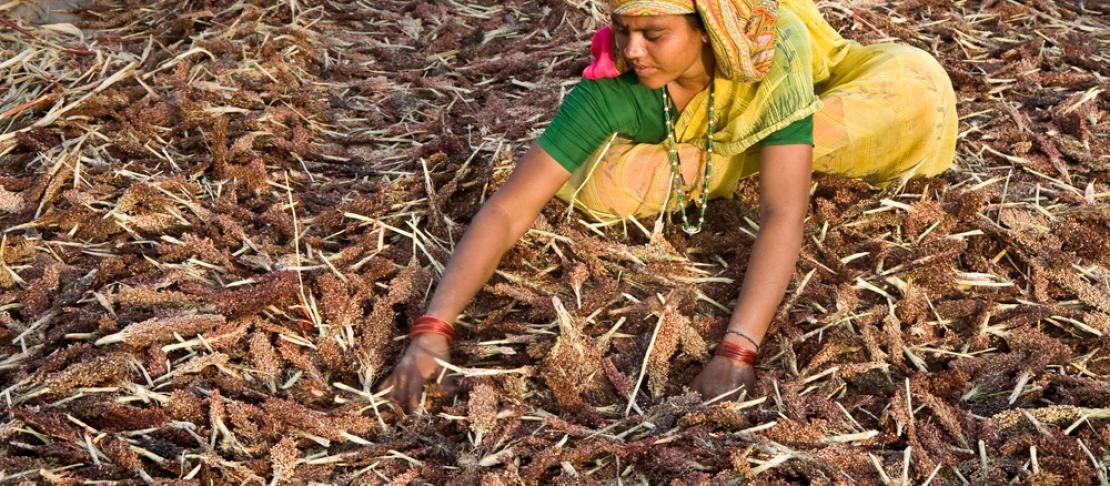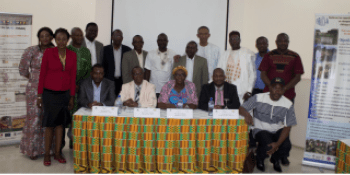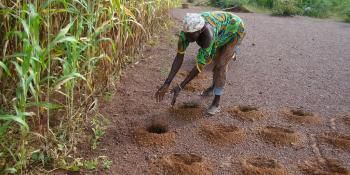Making genebanks 'climate-ready' to meet challenges of the future

In India, the National Bureau of Plant Genetic Resources (NBPGR) and Bioversity International have worked together to map hotspots for germplasm conservation and vulnerable areas for wheat, pearl millet, chickpea, pigeon pea and sorghum.
Many studies on climate change look into the agronomic impacts on crop. Like: what does a projected increase in temperatures mean for future wheat yields? But it is equally important to understand how germplasm- the genetic resources contained in a crop- make it resilient to or pre-adapted to certain climatic stresses such as severe or dry heat or short spells of rain.
By understanding this we can equip genebanks to host a diversity of 'climate- ready' seeds that could potentially meet the needs of farmers in the coming decades. Characterising, evaluating and documenting crop traits that can withstand the challenges placed by climate change is an important step towards preparing for future food security.
CCAFS South Asia supported a study undertaken by researchers at the National Bureau of Plant Genetic Resources (NBPGR) and Bioversity International to identify pre-adapted germplasm and potentially vulnerable areas for five select crops- wheat, pearl millet, chickpea, pigeon pea and sorghum in India. These are crops typically grown in the drylands and are an important source of food and nutrition to millions of people.
A glimpse into future climates
The study employed CCAFS climate analogues. The analogues help identify areas that experience statistically similar climatic conditions based on distribution of temperature and rainfall during cropping duration. Essentially, the method allows users a glimpse into the future by locating areas whose current climate is similar to the projected climate of a place of interest. For instance, if we know Paramakkudi in Tamil Nadu in south of India is projected to experience the weather of Barmer in Rajasthan in western India in the coming decades, what steps can we take to adapt farmers to such a climate scenario?
The study addresses this by identifying hotspots for germplasm collection to evaluate their performance in climate stressed environments. By mapping this against future climates, an atlas can be developed to match climate information against the germplasm accessions.
Visit the online atlas of the five select crops
Mining the data
To begin with, the research team collected information on 38,126 accessions- the unique identifier that captures diversity of plant population from a certain location- of the five target crops from the NBPGR and global datasets. In India, most of these crops are grown in the semi-arid and sub-humid regions, with most belonging to the hot semi-arid agro-ecological zone. The climatic attributes for the growing season were referenced for the different agro-ecological zones. The study focused on changes in the mean maximum temperature. In order to zoom in on areas most vulnerable to climate change the information was mapped using the geospatial processing program ArcMap.
Collection missions and capacity building
Following standard guidelines set by the NBPGR, a calendar of exploration and collection missions were carried out for sorghum and pearl millet. In many villages in Rajasthan, for instance, female farmers were able to share local seeds that were stored in bins and that have not been cultivated in many years.

Women farmers in rajasthan assisted the collection missions by sharing local seeds varieties that are stored in traditional bins. Photo: D.P.Semwal O.P. Dhariwal
Alongside the collection missions, capacity building programmes were also held with national scientists to show how the climate analogue tool could be used for plant genetic resource management and how geo-spatial tools can be used for mapping genetic diversity.
Future prospects
The study has added value to existing conserved germplasm and their ability to contribute to climate adaptation and make them ‘climate ready’. Research was limited by several factors such as: lack of local temperature data, limitations of the local climate models and the need to rely solely on climate attributes in the site selection in the absence of precise data on soils and other attributes.

The interactive online portal is available at www.nbpgr.ernet.in:8080/climate/arcMap.aspx
An interactive online information system PGR-Clim has also been developed to allow users to visualise how climate change will impact future plant genetic resources.
Sunil Archak is a Senior Scientist at the National Bureau of Plant Genetic Resources (Indian Council of Agriculture Research). This blog was edited by Dharini Parthasarathy, Communications Specialist, CCAFS South Asia.



